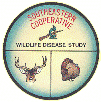Southeastern Cooperative Wildlife Disease Study

Southeastern Cooperative Wildlife Disease Study: Publications
Document Type
Article
Date of this Version
January 2005
Abstract
Dr. Tom Thorne, a 36-year veteran of the Wyoming Game and Fish Department, and his wife, Dr. Beth Williams, a professor of pathology at the University of Wyoming, were killed in a tragic automobile accident on December 29, 2004.
Dr. Al Kocan, recently retired professor of parasitology from Oklahoma State University, died of an apparent heart attack on December 15, 2004.
SCWDS Studies on Johne’s Disease in Wildlife Johne’s disease is a chronic, progressive disease of the gastrointestinal tract and lymphoid tissue that is caused by the bacterium Mycobacterium avium subspecies paratuberculosis (Map). Johne’s disease is known primarily as a disease of domestic ruminants, especially cattle, but infections also have been found in wildlife. Culture-positive specimens came from 11 wild and feral species: nine-banded armadillo, common snipe, Eastern cottontail, European starling, feral cat, hispid cotton rat, house sparrow, northern short-tail shrew, opossum, raccoon, and striped skunk.
WNV Antibody Persistence in Pigeons
Feral Swine Distribution Maps: Feral swine can serve as reservoirs for pseudorabies virus (PRV) and Brucella suis, and these pathogens have been detected in feral swine populations throughout much of their range in the United States. Two maps of the nationwide distribution of feral swine have been completed.
A new study funded by the University of Georgia Research Foundation has been initiated at SCWDS to investigate piroplasm infections in southeastern wildlife. Piroplasm infections are caused by intraerythrocytic protozoans in the genera Babesia, Theileria, and Cytauxzoon. Babesia microti, the primary cause of human babesiosis in the United States, is maintained in nature by several species of rodents as reservoir hosts and the tick Ixodes scapularis as the vector. In addition to B. microti, three undescribed species of piroplasms have been recognized as human pathogens in the United States.
During the past deer hunting season a hunter acquired Mycobacterium bovis from an infected deer in northeastern Michigan.
In October 2004, a previously healthy 15-year-old girl from Fond du Lac County, Wisconsin, became the first human documented to recover from clinical rabies who had not had pre- or post-exposure prophylaxis for rabies. There is no proven treatment for clinical rabies, and although this patient recovered from rabies, the reasons for recovery in this unusual case are unknown.


Comments
SCWDS Briefs is available online at http://www.uga.edu/scwds/briefs.htm
Published by the Southeastern Cooperative Wildlife Disease Study. Used by permission.